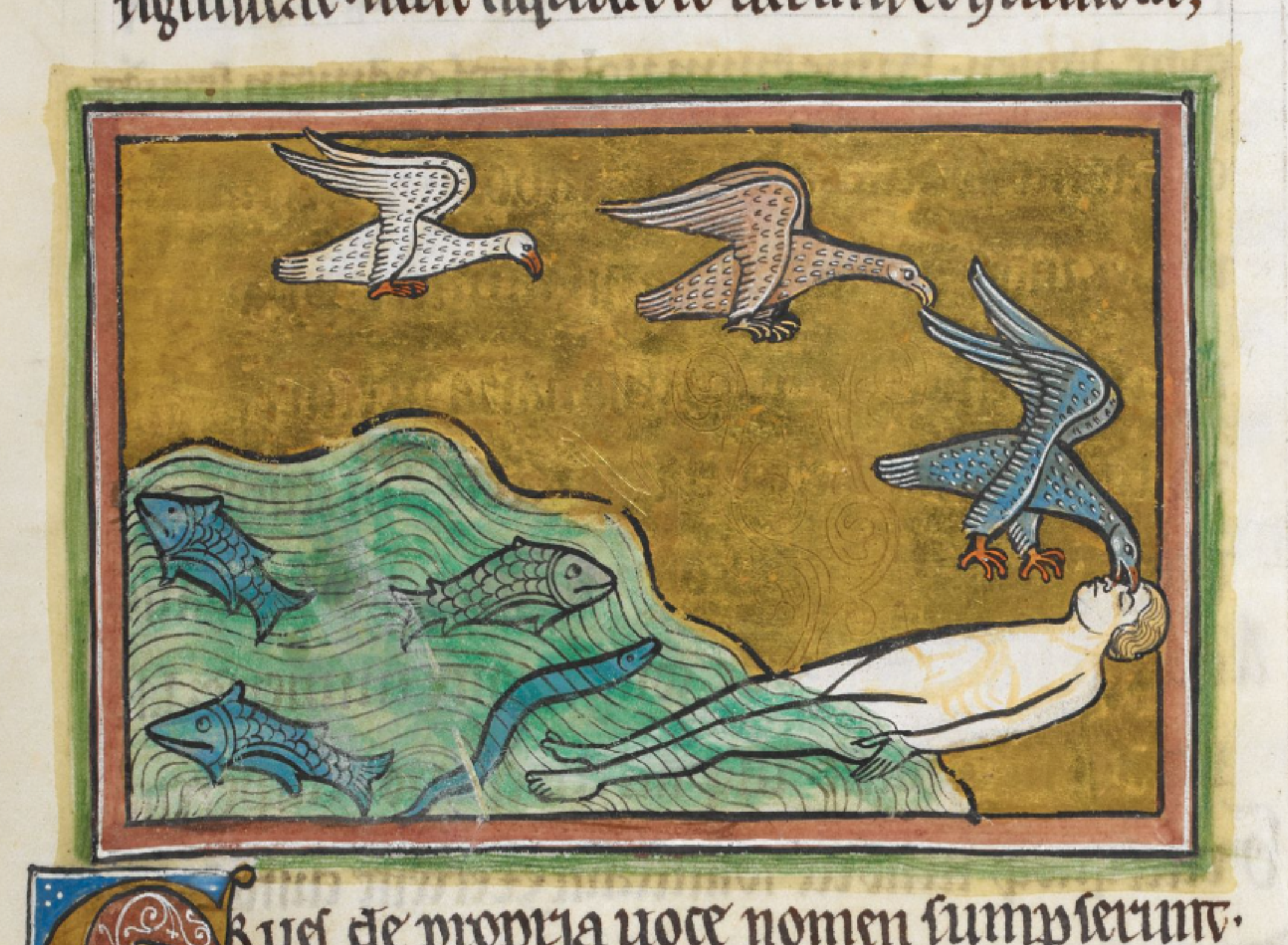Vulture, Rochester Bestiary, c.1230
In this fascinating exploration, the vulture emerges as a symbol abounding with allegorical significance, embodying themes of mystery, mortality, and even spiritual enlightenment. Named after its slow flight and inability to soar swiftly, the vulture is depicted as a creature that defies conventional expectations.
Central to the vulture's mystique is its ability to reproduce without mating, a phenomenon that echoes the miraculous conception attributed to the Blessed Virgin Mary. Unlike vultures, humans are prone to ridicule and scepticism, yet the vulture stands as a reminder of the sacred mysteries that transcend human comprehension.
Furthermore, the vulture's longevity, with chicks purportedly capable of living up to a hundred years, serves as a poignant reminder of the eternal truths that persist beyond the transient realm of mortal existence. As creatures that perceive beyond the veil of human understanding, vultures are portrayed as silent witnesses to the hidden truths obscured by the darkness of earthly limitations.
Intriguingly, the vulture's association with death and foretelling of human demise emphasises its dual nature as both a symbol of uncleanliness and a representation of Christ. Just as the vulture descends from above to feed on carrion, so too is Christ likened to the vulture, descending from high heaven to unite humanity with Himself through His sacrificial death.
Despite its association with uncleanliness and rapacity, the vulture emerges as a symbolic of spiritual transcendence, embodying the paradoxical nature of Christ's redemptive mission. Just as the vulture serves a higher purpose beyond its earthly existence, so too does Christ offer salvation and renewal to humanity, transcending the limitations of mortality.
In the Old Testament, vultures are mentioned in contexts emphasizing their scavenging behaviour and association with death (Job 39:27-30) . In the New Testament, Jesus uses the imagery of vultures gathering around a carcass to illustrate the coming judgment (Matthew 24:28 , Luke 17:37 ).
dine quippe corporis precipites volatus non
habet. Wltures dicuntur non misceri concubitu. et
sine copula concipere et generare. natosque eorum;
usque ad centum annos procedere. Erubescant igitur qui
misteria nostra irrident. negantes beate virgini
marie; quod non negant vulturi. Wltures autem
sicut et aquile; etiam ultra maria cadavera senti-
unt. Altius quippe volantes. multa que hominibus
montium obscuritate celantur; ex alto illi conspiciunt.
Wltures mortes hominum signis quibusdam prenun-
tiare consueverunt. Unde cum bellum aliquod
mine; illuc tendunt. per hoc significantes multitudinem
homini casuram; que sibi possit esse. preda. Nomine
vulturis. aliquando dicitur imundus. et cupidis. et rapax. ali-
quando christi. Wltur enim rapacem significat et cupidum; qui
alienam mortem desiderat; ut sibi inde escam adquirat.
Lectione et habitus ostensione in celestibus habitans. sed cu-
piditate et rapacitate in visceribus terre manens. Unde
in levitico. vultur inter imundas aves reputatur. que
commedi non debent id est imitari. Vultur quoque dicitur
christus. Unde in iob. Semitam ignoravit avis. et sequitur.
Nec intuitus est oculos vulturis. Quia iudaicus populus
qui ignoravit semitam sapientie christi; non consideravit
oculos vulturis. idest intentionem christi. Mortem enim
christi vidit; sed quare moreretur non vidit. Et bene vul-
turis nomine christus dicitur. quia sicut vultur alis ab
alto descendit. ut carnem visam in esum recipiat; sic
christus ab alto celorum ad cadaver nostre mortalitatis
descendid. ut eam sibi in escam perpetuitatis prepararet.
Et sicut vultur sepe ad escam capitur; sic christus dum nos
sibi incorporavit; interficitur. Nec mireris quod vultur
aliunde est in mundus; et ex alia proprietate christum;
significat. sicut aquila et vermis et huiusmodi.
Further Reading
David Badke, The Bestiary Blog: Animals in the Middle Ages, Vulture, November 6 2023, https://bestiary.ca/beasts/beast233.htm
Mynott, J, Birds in the Ancient World (New York: Oxford University Press 2018)
Josh Goldenberg (BA 2012) and Matt Shanahan (BA 2014), Logeion, November 2022, https://logeion.uchicago.edu/
Castiglioni, L. and Mariotti, S. (1996). Vocabolario della Lingua Latina: Latino-Italiano Italiano-Latino. Terza Edizione. Loescher Torino
Curley, M. J., Physiologus: A Medieval Book of Nature Lore (University of Chicago edition 2009)
Rackham, H., M.A., Pliny Natural History Volume III, Libri VIII-XI (London: William Heinemann Ltd, 1949)
Collins, A. H., M.A., Symbolism of Animals and Birds (New York: McBride, Nast & Company, 1913)
Henderson, C., The Book of Barely Imagined Beings (London: University of Chicago Press, 2013)
White, T. H., The Bestiary: A Book of Beasts (New York: G.P Putnam’s Sons, 1960)
Matthews, J. and Matthews C., The Element Encyclopedia of Magical Creatures: The Ultimate A-Z of fantastic beings from myth and magic (London: HarperElement, 2005)
Barney, S. A., Lewis, W. J., Beach A., Berghof O., The Etymologies of Isidore of Seville (New York: Cambridge University Press, 2006)
Endnotes
[1] Job NKJV 39:27-30: “Does the eagle mount up at your command, And make its nest on high? On the rocks it dwells and resides, On the crag of the rock and the stronghold. From there it spies out the prey; Its eyes observe from afar. Its young ones suck up blood; And where the slain are, there it is."
[2] Matthew NKJV 24:28: “For wherever the carcass is, there the eagles will be gathered together.”
[3] Luke NKJV 17:37: “Two women will be grinding together: the one will be taken and the other left. Two men will be in the field: the one will be taken and the other left.” And they answered and said to Him, “Where, Lord?” So He said to them, “Wherever the body is, there the eagles will be gathered together.”
[4] ob NKJV 28:7: “That path no bird knows, Nor has the falcon’s eye seen it.”

